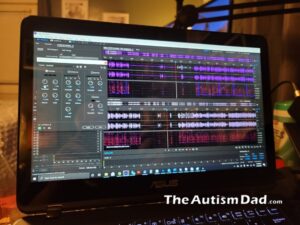Service animals are fantastic for helping people with disabilities go about their daily routines. Someone who is blind may greatly benefit from a seeing-eye dog that helps them navigate city streets.
Alternatively, service dogs can also be used to assist young children with autism spectrum disorder (ASD). Children with autism vary in how much they are affected, but a service dog can be effective in just about any situation.
A service dog serves as a medium between a child with ASD and the outside world. Through interacting, spending time together, and navigating life side-by-side, a service dog to support autism can make life much better for a child and their family.
If your child has ASD, then you may wonder how a service dog can help. We’ll go over this below so you can determine if a service dog will benefit your child!
Providing a Calming Presence
Arguably the greatest perk of a service dog for autism is providing a calming presence.
For a child with ASD, emotions and senses are extremely overwhelming. Anything is often felt strongly and can have an adverse reaction.

Especially in new environments, it’s easy to get overstimulated. This is particularly challenging for someone with autism because it can lead to a meltdown.
Before having a meltdown, most children with ASD will display several anxious behaviors in response to the stimuli. This where a service dog can be extremely helpful.
When a child is becoming overstimulated, a service dog can detect this and quickly fix the situation. Whether that’s just by being there, nudging the child, or leading them away from the area, a dog can calm an anxious child with ASD.
The other part of this is having a service dog will provide a source of comfort wherever the child is. As a result, it will make them more at ease overall and less likely to get overwhelmed.
This means that a service dog decreases sensory arousal and can assuage overstimulation.
Improving Communication
Service dogs are also effective at improving communication skills for a child with ASD.
Children with autism tend to have difficulty interacting with others. They may not be able to properly convey their intentions, struggle to understand what someone else says or fail to pick up on social cues.
With a service dog, a child with ASD can interact with it and learn communication skills that translate to human interaction. Dogs are highly predictable and easy to communicate with, which allows for effective practice at interaction.
As a child with autism spends more time with their service dog, they will begin to pick up nonverbal cues exhibited by the dog. This skill will help them detect nonverbal cues made by humans they interact with.
Putting this together, interacting with a service dog effectively teaches children with autism how to read and communicate with others.
Strengthening Relationships
Through the bond and sharpened functionality that a service dog encourages, a child with autism can create stronger relationships with others.
A child that has ASD often struggles to create close relationships with others. They often feel misunderstood, rejected, and alone.
A service dog is the ultimate faithful companion and allows children with autism to form a bond. This activates their capacity to form bonds with others, having an example to draw from.
Furthermore, a child’s ability to better communicate also makes them feel more connected to others. This will make them more likely to engage and interact with peers and family members, which is necessary to form strong relationships.
With this in mind, a service dog creates better connections by improving communication and showing a child that they can bond with others.
Increasing Safety
Lastly, a service dog will greatly increase the safety of a child.
A child with ASD is inherently at risk because they are not always in control of themselves. Should a meltdown occur, they are vulnerable to whoever is around them at that time.
Service dogs are useful here because they keep a child mellow. When a child with autism can stay level-headed, they’re able to stay in control.
The other side of this is that any child is naturally safer with a dog around. Predators are less likely to attack someone with a dog because there is a risk of getting bitten.
A final consideration is that children with ASD who are supported by a service dog tend to get treated better. Many people like dogs and feel comfortable around them. This extends to your child, who is less likely to be harassed.
Service dogs are perfect for making your child safer. They will physically protect them and keep their emotions in check.
Closing Thoughts
A unique solution to a child suffering from autism is to pair them with a service dog. This will alleviate many symptoms and help them to live a more normal, reliable life.
Specifically, service dogs can benefit children with ASD in four primary ways. This includes providing a calming presence, improving communication skills, strengthening relationships, and increasing their safety.
While service dogs can assist with autism, it is not a guarantee. It depends on your child’s unique situation and the dog they are paired with. If a service dog is something you can accommodate, consider it as an option to improve your child’s life.
This is a contributed post and therefore may not reflect the views and opinions of this blog or its author.



